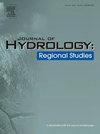Characterization of drought propagation over the Tibetan Plateau
IF 4.7
2区 地球科学
Q1 WATER RESOURCES
引用次数: 0
Abstract
Study region
This study was carried out on the Tibetan Plateau (TP), which contains multiple important ecosystems, is the source of many rivers in China, and is experiencing significant climate change.
Study focus
Clarifying drought propagation characteristics is crucial for understanding the mechanism of drought development and benefiting drought mitigation and early warning schemes. However, there is currently a notable lack of research on droughts on the TP and drought propagation characteristics on the TP have yet to be investigated. In this study, we investigated drought propagation time, probability, threshold, and the climatic factors associated with drought development based on the copula probability model and correlation, Bayesian network, and attribution analyses, allowing us to fill current research gaps.
New hydrological insights for the region
The research framework proposed in this study effectively reflected the characteristics of drought propagation. Our results showed that seasonality and aridity controlled the propagation time from meteorological drought (MD) to agricultural drought (AD), i.e., the time was shortest in summer (2.3![]() 11.0 months) and in the humid zone (2.3
11.0 months) and in the humid zone (2.3![]() 7 months); the same pattern was found for the propagation of MD to hydrological drought (HD), with the propagation time being 2.3
7 months); the same pattern was found for the propagation of MD to hydrological drought (HD), with the propagation time being 2.3![]() 3.0 months in summer and 2.3
3.0 months in summer and 2.3![]() 6 months in humid zones. The propagation probability for both AD and HD generally increased synchronously with the severity of MD, and also exhibited seasonal patterns, with the highest probability values in summer (0.59
6 months in humid zones. The propagation probability for both AD and HD generally increased synchronously with the severity of MD, and also exhibited seasonal patterns, with the highest probability values in summer (0.59![]() 0.90 for AD and 0.51
0.90 for AD and 0.51![]() 0.82 for HD). The highest propagation thresholds were also found in summer (−1.68 to −1.09 for AD and −1.68 to −1.36 for HD). The trends of both propagation time and probability were significant, and the probability of HD exhibited significant downward trends (−0.074 to −0.030/decade) across the TP. Precipitation was the dominant factor controlling the development of drought in most cases; however, other climatic factors, such as maximum temperature, solar radiation, and specific humidity, contributed 14.0 %
0.82 for HD). The highest propagation thresholds were also found in summer (−1.68 to −1.09 for AD and −1.68 to −1.36 for HD). The trends of both propagation time and probability were significant, and the probability of HD exhibited significant downward trends (−0.074 to −0.030/decade) across the TP. Precipitation was the dominant factor controlling the development of drought in most cases; however, other climatic factors, such as maximum temperature, solar radiation, and specific humidity, contributed 14.0 %![]() 43.9 % of the variances of AD and HD.
43.9 % of the variances of AD and HD.
青藏高原干旱传播的特点
研究区域本研究在青藏高原(TP)进行,该地区包含多个重要生态系统,是中国许多河流的源头,并且正在经历显著的气候变化。研究重点阐明干旱传播特征对于了解干旱发展机制以及有利于干旱缓解和预警计划至关重要。然而,目前对大埔干旱的研究明显不足,大埔干旱的传播特征尚待研究。在本研究中,我们基于 copula 概率模型和相关性、贝叶斯网络和归因分析,研究了干旱传播时间、概率、阈值以及与干旱发展相关的气候因子,从而填补了目前的研究空白。研究结果表明,季节性和干旱程度控制了气象干旱(MD)向农业干旱(AD)的传播时间,即夏季(2.311.0 个月)和湿润区(2.37 个月)的传播时间最短;气象干旱向水文干旱(HD)的传播也存在同样的规律,夏季的传播时间为 2.33.0 个月,湿润区为 2.36 个月。旱灾(AD)和水文干旱(HD)的传播概率一般与旱灾(MD)的严重程度同步增加,并呈现出季节性规律,夏季的概率值最高(旱灾(AD)为 0.590.90,水文干旱(HD)为 0.510.82)。夏季的传播阈值也最高(AD 为-1.68 至-1.09,HD 为-1.68 至-1.36)。传播时间和传播概率的趋势都很显著,HD 的传播概率在整个热带降雨过程中呈显著的下降趋势(-0.074 至-0.030/十年)。在大多数情况下,降水是控制干旱发生的主导因子;然而,其他气候因子,如最高气温、太阳辐射和比湿度,也占旱灾和旱灾概率变异的 14.0 %43.9 %。
本文章由计算机程序翻译,如有差异,请以英文原文为准。
求助全文
约1分钟内获得全文
求助全文
来源期刊

Journal of Hydrology-Regional Studies
Earth and Planetary Sciences-Earth and Planetary Sciences (miscellaneous)
CiteScore
6.70
自引率
8.50%
发文量
284
审稿时长
60 days
期刊介绍:
Journal of Hydrology: Regional Studies publishes original research papers enhancing the science of hydrology and aiming at region-specific problems, past and future conditions, analysis, review and solutions. The journal particularly welcomes research papers that deliver new insights into region-specific hydrological processes and responses to changing conditions, as well as contributions that incorporate interdisciplinarity and translational science.
 求助内容:
求助内容: 应助结果提醒方式:
应助结果提醒方式:


